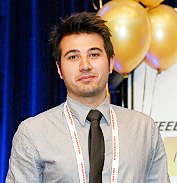26 Oct 2017
UNLOC project receiver is simpler and cheaper, requiring just a quarter of the detectors used in conventional devices.
Researchers at UCL, London, say that a new optical communications module they have developed could make slow internet speeds and the commonly-experienced drop in speed at peak times a thing of the past.Consistent high-speed broadband connectivity is the UCL claim for its new receiver technology that enables dedicated data transmission rates of more than 10,000 megabits-per-second (equivalent to 1.25 gigabytes) for a super-fast but low-cost broadband connection,potentially to every home.
Lead researcher Dr Sezer Erkılınç of UCL’s Electronic & Electrical Engineering department, commented, “UK broadband speeds are woefully slow compared to many other countries, but this is not a technical limitation.”He explained why such a significant upgrade is necessary: “Although 300 Mb/s may be available to some, average UK speeds are currently just 36 Mb/s. By 2025, average speeds over 100 times faster will be required to meet increased demands for bandwidth-hungry applications such as ultra-high definition video, online gaming, and the Internet of Things.”
“The future growth in the number of mobile devices, coupled with the promise of 5G to enable new services via smart devices, means we are likely to experience bandwidth restrictions; our new optical receiver technology will help combat this problem.”
The scientists from the UCL Optical Networks Group and the University of Cambridge have developed a new, simplified receiver for use in optical access networks – the links connecting internet subscribers to their service providers. The project has been funded by EPSRC’s UNLOC Programme and Huawei Technologies. The group’s work has recently been published in Nature Communications.

UCL’s Dr Sezer Erkılınç.
Co-author and Head of the Optical Networks Group, Professor Polina Bayvel continued, “To maximise the capacity of optical fiber links, data is often transmitted multiplexed using different wavelengths. Ideally, we’d dedicate a wavelength to each subscriber to avoid the bandwidth sharing between the users.
Although this is already possible using highly sensitive hardware, known as coherent receivers, these devices are costly and only financially viable in core networks that link countries and cities. Their cost and complexity has so far prevented their introduction into the access networks and limits the support of multi-Gb/s broadband rates available to subscribers.”
The new receiver retains many of the advantages of coherent receivers, but is simpler, cheaper, and smaller, requiring just a quarter of the detectors used in conventional devices. The simplification was achieved by adopting a coding technique to fiber access networks that was originally designed to prevent signal fading in wireless communications. This approach has the additional cost-saving benefit of using the same optical fiber for both upstream and downstream data.
Dr Erkılınç added, “This simple receiver offers users a dedicated wavelength, so user speeds stay constant no matter how many users are online at once. It can co-exist with the current network infrastructure, potentially quadrupling the number of users that can be supported and doubling the network’s transmission distance/coverage.”
The receiver was tested on a dark fiber network installed between Telehouse (in east London), UCL (central London) and Powergate (west London). The team successfully sent data over 37.6 km and 108 km to eight users who were able to download/upload at a speed of at least 10 Gb/s. This is more than 30 times faster than the fastest broadband typically available in the UK, today.
“BT Openreach recently announced that fibre access is a key focus and must improve. With high-capacity broadband a priority for the UK government, we will be working to reduce the electrical power requirements of this technique to make this commercially viable in the nearest future. We believe that it has real potential to provide high-speed broadband connectivity to every home, which will support the growing digitally enabled economy in the years to come,” concluded Professor Bayvel.
| © 2026 SPIE Europe |
|